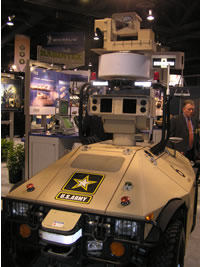As result of teamwork between the U.S. Army Research Laboratory (ARL) and General Dynamics Robotic Systems (GDRS), TAC-C has been developed to explore new missions for tactical class robotic vehicles. The vehicle can carry up to 2,000 lbs (907 kg) of cargo, providing deployed units with various logistical support services, such as delivery of supplies or casualties evacuation. TAC-C also provides a platform for the deployment of unmanned aerial systems (UAS). The vehicle can be employed on autonomous missions or be driven manually.
The vehicle has a steering column and driver’s seat that can be stowed away or deployed in a matter of seconds, TAC-C can also be man-driven and used to transport up to five troops. The vehicle has a front and rear steering, which also enable crab steering when required, enabling turning radius as small as three meters.
The vehicle uses Continuously Variable Transmission (CVT) to enable smooth transfer of power to the wheels, maintaining positive traction even in difficult conditions. Maximum speed when manually driven is 80 mph., using 2 wheel, 4 wheel or ultra-low gears for the most rugged terrain. When operated in an autonomous mode, TAC-C can travel at speeds of 20 mph cross country. Semi-active suspension is used to reduce signature to a low, ground hugging mode or raise the chassis for maximum ground clearance. In the medical evacuation role, the vehicle can be utilized as an autonomous or soldier driven vehicle. In both configurations it can carry two litters with wounded soldiers, and a MEDEVAC kit including an EKG monitor, IV hookup and other medical supplies.
















